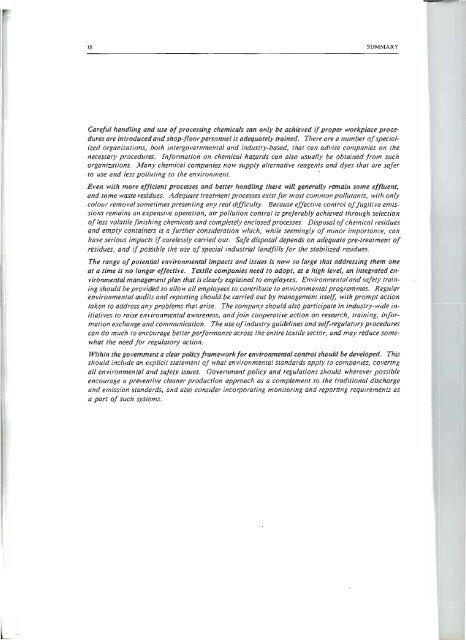Contributor, The Textile Industry and the Environment, UNEP
Contributor, The Textile Industry and the Environment, UNEP
Contributor, The Textile Industry and the Environment, UNEP
Create successful ePaper yourself
Turn your PDF publications into a flip-book with our unique Google optimized e-Paper software.
18 SUMMARY<br />
Careful h<strong>and</strong>ling <strong>and</strong> use of processing chemicals can only be achieved if proper workplace procedures<br />
are introduced <strong>and</strong> shop-floorpersonnel is adequately trained. <strong>The</strong>re are a number ofspecialized<br />
organizations, both intergovernmental <strong>and</strong> industry-based, that can advise companies on <strong>the</strong><br />
necessary procedures. Information on chemical hazards can also usually be obtained from such<br />
organizations. Many chemical companies now supply alternative reagents <strong>and</strong> dyes that are safer<br />
to use <strong>and</strong> less polluting to <strong>the</strong> environment. '<br />
Even with more efficient processes <strong>and</strong> better h<strong>and</strong>ling <strong>the</strong>re will generally remain some effluent,<br />
<strong>and</strong> some waste residues. Adequate treatment processes exist for most common pollutants, with only<br />
colour removal sometimes presenting any real difficulty. Because effective control offugitive emissions<br />
remains an expensive operation, air pollution contra! is preferably achieved through selection<br />
ofless volatilelmishing chemicals <strong>and</strong> completely enclosedprocesses. Disposal ofchemical residues<br />
<strong>and</strong> empty containers is a fur<strong>the</strong>r consideration which, while seemingly of minor importance, can<br />
have serious impacts if carelessly carried out. Safe disposal depends on adequate pre-treatment of<br />
residues, <strong>and</strong> ifpossible <strong>the</strong> use ofspecial industrial l<strong>and</strong>fills for <strong>the</strong> stabilized residues.<br />
<strong>The</strong> range of potential environmental impacts <strong>and</strong> issues is now so large that addressing <strong>the</strong>m one<br />
at a time is no longer effective. <strong>Textile</strong> companies need to adopt, at a high level, an integrated environmental<br />
management plan that is clearly explained to employees. <strong>Environment</strong>al <strong>and</strong> safety (raining<br />
should be provided to allow all employees to conlribute to environmental programmes. Regular<br />
environmental audits <strong>and</strong> reporting should be carried out by management itself with prompt action<br />
taken to address any problems (hat arise. <strong>The</strong> company should also participate in industry-wide initiatives<br />
to raise environmental awareness, <strong>and</strong> join cooperative action on research, training, information<br />
exchange <strong>and</strong> communication. <strong>The</strong> use ofindustry guidelines <strong>and</strong> self-regulatory procedures<br />
can do much to encourage beller performance across <strong>the</strong> entire textile sector, <strong>and</strong> may reduce somewhat<br />
<strong>the</strong> need for regulatory action.<br />
Within <strong>the</strong> government a clear policy fram ework for environmental control should be developed. This<br />
should include an explicit statement of what environmental st<strong>and</strong>ards apply to companies, covering<br />
all environmental <strong>and</strong> safety issues. Government policy <strong>and</strong> regulations should wherever possible<br />
encourage a preventive cleaner production approach as a complement to <strong>the</strong> traditional discharge<br />
<strong>and</strong> emission st<strong>and</strong>ards, <strong>and</strong> also consider incorporating monitoring <strong>and</strong> reporting requirements as<br />
a part of such systems.

















